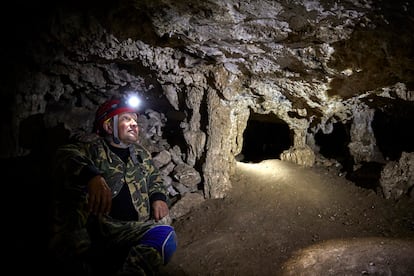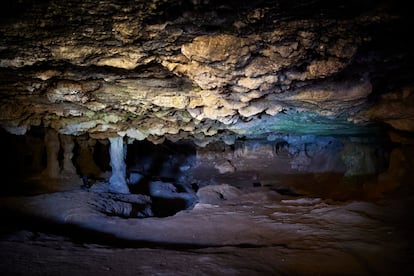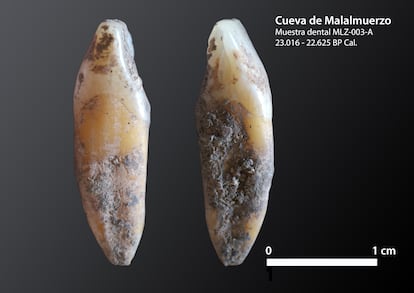The Spanish cave where ‘Homo sapiens’ sat out 5,000 years of European glaciation
The Malalmuerzo cave in Granada is estimated to have been home to up to 250 generations of early humans during the Last Glacial Maximum, which devastated Europe 19,000-25,000 years ago.

The Malalmuerzo cave, located in Moclín, in the Spanish province of Granada, was first inhabited around 30,000 years ago. According to the estimates of Pedro Cantalejo, a researcher of cave paintings and the now-retired curator of the Ardales cave in Málaga, generations of Homo sapiens, all probably descendants of one another, occupied the Malalmuerzo cave for 18,000 years, serving as a refuge for numerous generations of sapiens during the Last Glacial Maximum, which devastated Europe 19,000-25,000 years ago.
During that era, modern-day France, Germany, and Poland were totally covered by ice, devoid of flora or fauna, but inhabitants of the Iberian Peninsula lived a very different reality. The south of the region, particularly, was a livable space. In the area where the Malalmuerzo cave is located, according to Cantalejo, the temperature would have been around seven degrees Celsius below today’s average. These temperatures allowed humans to survive by providing them with fauna and vegetation, a fundamental source of food. Thus, the Malalmuerzo cave, on the banks of the Velillos River, became a refuge of transition and salvation for Homo sapiens until the glacial age receded. in 2017, a tooth was found in the cave and dated as belonging the to the second-oldest Homo sapiens yet discovered in Europe.
During the Upper Paleolithic, between 23,000 and 19,000 years ago, ice and low temperatures affected areas to the east of Granada, but to west, in the mountainous area containing modern-day Loja, there were “immense conifer forests of and plenty of fauna, including large animals such as horses, bulls and mountain goats,” says Cantalejo. The Velillos River, around 500 meters from the mouth of the cave, also provided a source of water. Cantalejo estimates that in each generation, families of between 8 and 12 people “at the most” occupied Malalmuerzo. The researcher also says that during the 5,000 years of the Last Glacial Maximum, the cave was permanently inhabited and that up to 250 generations of humans might have lived there.
José Manuel Fernández Sánchez, a retired history teacher, speleologist, and the cave’s caretaker, explains that Malalmuerzo, which is about 400 meters deep and follows a linear route fragmented into three main rooms — the entrance and two more decorated with Paleolithic paintings linked by narrow tunnels that can only be traversed by crawling — has been plundered several times during the last century. Thieves have removed artefacts from the Paleolithic and Neolithic, the two periods during which the cave was occupied, for sale on the black market. Not only has the heritage been lost, but also the correct stratification of the materials in the cave: in other words, the oldest remains are no longer always to be located among the bottom layers.

The first room is a large space, 13 meters deep and sloping downhill, with various chambers and an open space in its central part. It is the only part of the cave that receives natural light and served as the living area. This room, says Cantalejo, had several characteristics that made it habitable: the inner part of the chamber provided a “climatic mattress” with a stable temperature of 15ºC to 16ºC, unaffected by the elements outside, while the incline allowed smoke from fires to be released. Crucially, from inside its inhabitants could see what was going on outside, but they remained out of view of prying eyes. From there, a tunnel of about 15 meters in length, which is accessed through a cavity a little wider than an adult body, leads to the chamber containing Paleolithic paintings where, according to Cantalejo, “they did not live, but were creating what we now consider art, which then would have represented something ritual or cultural.”
The cave art contained in Malalmuerzo has been documented and studied over the past 40 years. The difficulty of reaching these deeper cavities is probably what saved the paintings from looters but the main room, where the Homo sapiens lived, has been open to plunder for decades. Even so, says Cantalejo: “The scenography we see now is the same as when it was inhabited.”
In the early 1980s a particular piece from the cave - a stone axe blade with a mountain goat carved on it – was sold on the black market for one million pesetas (around €6,000). That attracted more looters and chaos ensued, says Fernández Sánchez. In 2016, he discovered that someone had been trying to access a hidden cavity for some time. Fernández Sánchez replaced an old padlock that had been used to secure the cavity with a more complex security device.

The hole opened up by the looters gave access to a cavity of just over a cubic meter. Cantalejo and a group of eight people worked there for a week, starting from the ground up. They only managed to penetrate 18 centimeters deep because the wall was calcified. However, they found more than 2,000 pieces of flint, animal remains a perfectly preserved tooth. Analysis by the Max Planck Institute of Geoanthropology in Germany determined it belonged to the second-oldest Homo sapiens known to science in Europe (the oldest to date was discovered in Belgium). The molar belonged to a young man, aged between 25 and 30, who was in good
Cantalejo and his team worked without funding and money was scarce, but the researcher knew the director of genetic analysis at Max Planck from previous work they had done together. He called him and they met in Germany: “I didn’t trust him not to lose the tooth, so I put it in a plastic jar and it traveled in my pocket,” he says. In the absence of funding, the Spaniard and the German were forced to improvise: the tooth was included in an analysis of 350 pieces of human remains from European prehistory. The tooth no longer exists — it had to be destroyed for analysis — but the conclusion reached was that the southern Iberian Peninsula experienced a glaciation completely different to the one their peers in Central Europe suffered and in the Malalmuerzo cave in Granada, life went on practically as normal. In addition, the cave’s inhabitants bequeathed all subsequent Homo sapiens with the memory of their DNA.
Today, the cave remains closed while it is decided if further investigation is warranted. Fernández Sánchez is convinced that in the same room where the tooth was found there is more interesting material to uncover. In fact, it is the only space in the cave where he insists visitors wear a mask. He believes that it could be a space where carried the belongings of those who lived there. Cantalejo, on the other hand, thinks that is could “the garbage room,” where everything that was not of use was thrown. The mayor of Moclín, Marcos Pérez, says that it will be up to the regional government of Andalusia to decide on any future project for the cave.
Sign up for our weekly newsletter to get more English-language news coverage from EL PAÍS USA Edition
Tu suscripción se está usando en otro dispositivo
¿Quieres añadir otro usuario a tu suscripción?
Si continúas leyendo en este dispositivo, no se podrá leer en el otro.
FlechaTu suscripción se está usando en otro dispositivo y solo puedes acceder a EL PAÍS desde un dispositivo a la vez.
Si quieres compartir tu cuenta, cambia tu suscripción a la modalidad Premium, así podrás añadir otro usuario. Cada uno accederá con su propia cuenta de email, lo que os permitirá personalizar vuestra experiencia en EL PAÍS.
¿Tienes una suscripción de empresa? Accede aquí para contratar más cuentas.
En el caso de no saber quién está usando tu cuenta, te recomendamos cambiar tu contraseña aquí.
Si decides continuar compartiendo tu cuenta, este mensaje se mostrará en tu dispositivo y en el de la otra persona que está usando tu cuenta de forma indefinida, afectando a tu experiencia de lectura. Puedes consultar aquí los términos y condiciones de la suscripción digital.
More information
Archived In
Últimas noticias
Most viewed
- Oona Chaplin: ‘I told James Cameron that I was living in a treehouse and starting a permaculture project with a friend’
- Reinhard Genzel, Nobel laureate in physics: ‘One-minute videos will never give you the truth’
- Sinaloa Cartel war is taking its toll on Los Chapitos
- Why the price of coffee has skyrocketed: from Brazilian plantations to specialty coffee houses
- Silver prices are going crazy: This is what’s fueling the rally









































